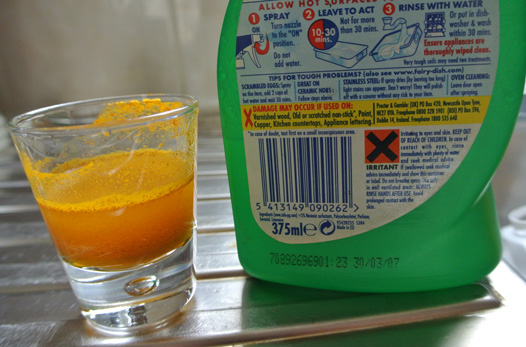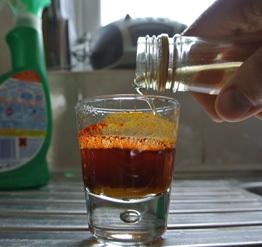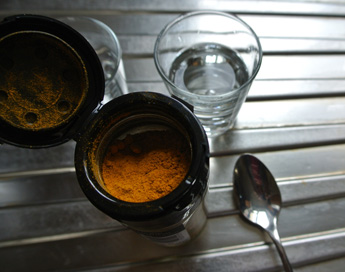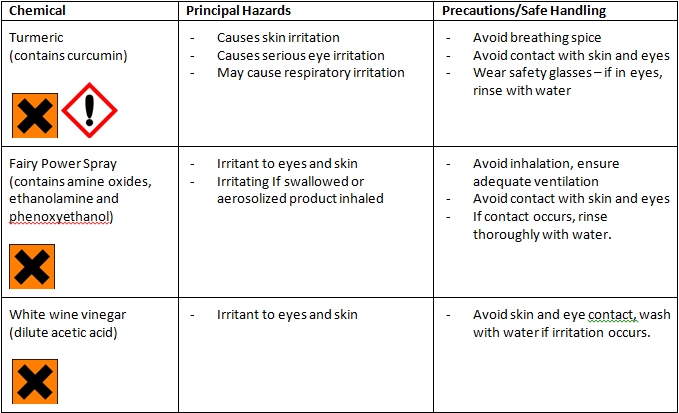Turmeric: a natural indicator
Project created by: Dr Natalie Fey and Dr Ben Mills
The NFWI has teamed up with the University of Bristol to create a series of worksheets for you to try with your WI. This month learn the basics of the pH scale using a spice rack staple...
What’s involved?
Mixing turmeric with water, then adding household acids and bases to it to get it to change colour.

You will need:
- A glass or disposable plastic cup – turmeric can stain
- A teaspoon
- A suitable work surface – such as a stainless steel sink or a glass surface protector
- Water – tap water is fine
- Turmeric
- Kitchen cleaning spray – you want fairly strong stuff that is soapy, rather than a vinegar-based cleaner (both Fairy Power Spray and Mr Muscle Kitchen Cleaner worked for us)
- Vinegar
Safety
The ingredients for this experiment are common household items, but it is sensible to remind ourselves of a few safety tips before we begin.
Kitchen cleaning sprays are usually a mixture of compounds that can irritate eyes and skin. Because they are sprays, they can also irritate airways. Have a quick look at the warnings on the bottle. If contact does occur, wash thoroughly with water.
Workspace and activity
Turmeric can leave yellow stains, so try to find a work surface that is unlikely to become stained – a stainless steel kitchen sink or glass surface protector would work.
Avoid working over a carpeted area or on unfinished wood, have a cloth or kitchen roll to hand. If your kitchen worktop ends up with a bit of a stain, the kitchen cleaning spray may well be useful to get this off. Avoid spraying kitchen cleaner at people and ensure good ventilation.
And finally, it can be helpful to have some thick gloves and newspaper ready to help you collect and wrap up any glass breakages that happen.
Procedure
- Step 1: Put some water into your glass or cup. You don’t need a lot; a half-full shot glass is sufficient.
- Step 2: Use a teaspoon to add a small amount of turmeric to the water and give it a good stir. Little will dissolve, but it should colour the water yellow.
- Step 3: Spray 1-2 squirts of your kitchen cleaner into the turmeric solution in the glass. You should now see a colour change to dark red.
- Step 4: Once you have observed a colour change, add a little vinegar to the solution and see if you can return it to the original colour (yellow).
- Step 5: Wash your solution down the sink with lots of water and clean up any spillages.


Brief explanation
Turmeric contains a compound called curcumin, which is a naturally occurring indicator. Indicators are molecules that change colour depending on the pH of a solution.
For curcumin, this means it is yellow in acidic and neutral solutions (up to pH 7.5), and red in more basic solutions (to about pH 8.4).
The kitchen cleaning spray is basic and so it has a high pH (the older word for basic is alkaline). Spraying it into the water changes the pH of the solution; the solution becomes more basic, causing the colour change to the red form of curcumin. Adding vinegar, which is a weak acid, makes the solution acidic, so the yellow form of curcumin dominates again. And you can even observe a gradual colour change as it takes a bit of time for the acids and bases to mix and react.
Figure 1: The 2 forms of curcumin – yellow (left) below pH 7.5, red (right) above

The curcumin molecules start to decompose in both acidic and basic solution, so this stops working after a cycle, and because it starts out yellow, it cannot be used to detect acids very well.
Further information
Possible extension
You can dye some fabric (e.g. muslin) with turmeric in its yellow form and then change its colour to red by exposure to kitchen cleaner.
Extra safety advice: it’s a good idea to wear rubber gloves when handling the fabric after soaking in each solution.
Make up a fresh water/turmeric mixture and soak your fabric in it for a while (15-20 minutes). Rinse it to remove the spice and to avoid turmeric stains, and then squeeze out the water and leave to dry.
When you want to change its colour, spray it with your chosen kitchen cleaner. The colour change to red should be quick. Wearing rubber gloves, give the fabric a quick rinse with cold water (warm water seemed to wash out some of the colour), then squeeze out the water and leave it to dry. It is unlikely that these colours will withstand washing, so this is just a bit of fun rather than a way of making novelty garments.

Find more details and a full procedure on the RSC Learn Chemistry website.
